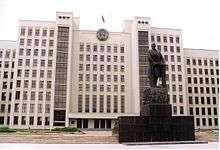Government House, Minsk
The Government House or House of Government (Belarusian: Дом урада, Russian: Дом правительства) is a government building in Minsk located on Independence Square. It houses the National Assembly of Belarus and its two chambers: the Council of the Republic and the House of Representatives (located in the right wing). The National Assembly is one of the highest organs of national power and symbolism in the country.[1] It was built in 1934 and designed by Iosif Langbard. It stands behind a statue of Vladimir Lenin and is one of the few buildings that survived the Great Patriotic War.[2]
| Government House | |
|---|---|
 | |

| |
| General information | |
| Architectural style | Constructivism |
| Location | Independence Square, Minsk |
| Country | Belarus |
| Coordinates | 53°53′46″N 27°32′41.2″E |
| Current tenants | Roman Golovchenko as Prime Minister of Belarus |
| Construction started | 1930 |
| Completed | 1934 |
| Owner | Government of Belarus |
| Design and construction | |
| Architect | Iosif Langbard |
History
The Government House was built between 1930 and 1934, becoming a vivid example of the constructivism architectural style as the largest public building of the pre-war Byelorussian SSR. In 1929, a competition for design of a new government workplace in Minsk took place, with the winner being Iosif Langbard, a native of the Grodno Region. The building was part of a project led by Langbard in that area which included a square (now known as Independence Square) used for civil/military parades on public holidays and a central grandstand for party leaders. He won the honorary title of Honored Artist of the Byelorussian SSR as a result of his work. Busts of Karl Marx and Friedrich Engels were sculpted and installed on the sides of the stairs leading to the premises of the Supreme Soviet. At the request of Langbard, a statue to Russian statesman and revolutionary Vladimir Lenin was erected in front of the house and the square, becoming the tallest of its kind in the entire USSR. During the occupation of Minsk by Nazi Germany during the Second World War, the headquarters of the local Gestapo was housed at Government House. The monument to Lenin was also overthrown, leaving only a pedestal with bas-reliefs. In 1945, the monument was restored after Victory in Europe Day.[3][4][5][6][7]
Gallery
 The Government House at night.
The Government House at night..jpg)

.jpg)


See also
References
- "03491". knowbysight.info. Retrieved 2019-06-03.
- "Stalinist architecture of Minsk". www.comtourist.com. Retrieved 2019-06-03.
- "Каким мог быть Дом правительства в Минске?". TUT.BY. 2010-09-25. Retrieved 2019-06-03.
- "Квартира рядом… с кабинетом". Советская Белоруссия. 2010-09-25. Retrieved 2019-06-03.
- https://planetabelarus.by/sights/dom-pravitelstva-v-minske/
- https://agentika.com/ru/encyclopedia/b1dc3f68-6f4e-4297-9cb9-535196800a7f/places/root/de06d15b-855a-4bfd-a7f9-60e1fe7dbfe7?version=eNw-1
- https://www.snp.by/news/dom-pravitelstva-respubliki-belarus/
External links
| Wikimedia Commons has media related to House of Government (Minsk). |